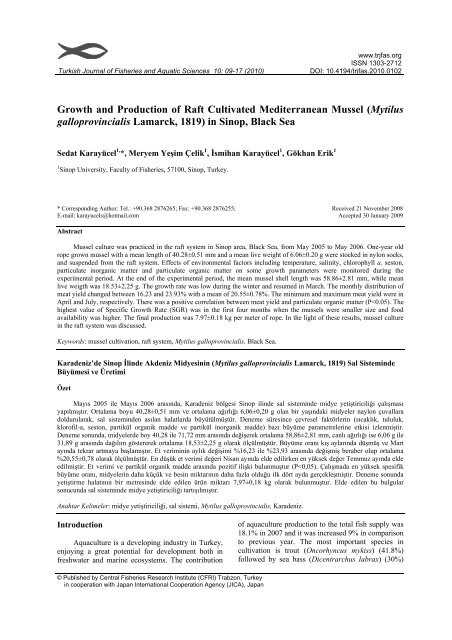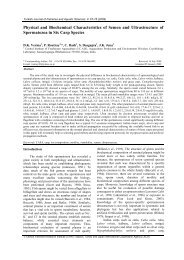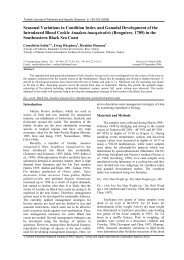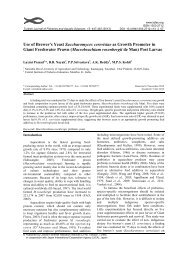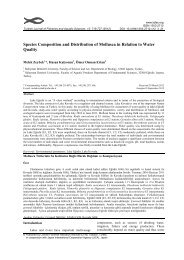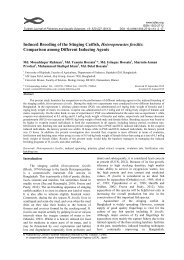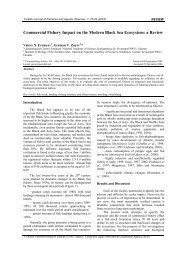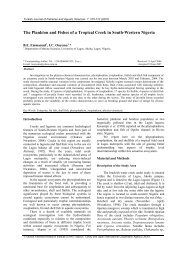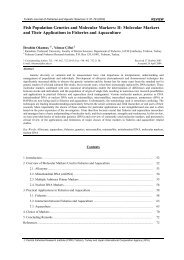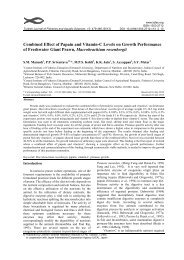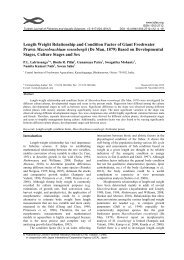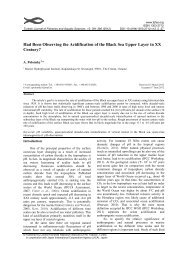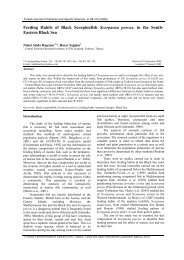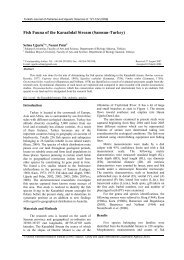(Mytilus galloprovincialis Lamarck, 1819) in Sinop, Black Sea
(Mytilus galloprovincialis Lamarck, 1819) in Sinop, Black Sea
(Mytilus galloprovincialis Lamarck, 1819) in Sinop, Black Sea
You also want an ePaper? Increase the reach of your titles
YUMPU automatically turns print PDFs into web optimized ePapers that Google loves.
Turkish Journal of Fisheries and Aquatic Sciences 10: 09-17 (2010)<br />
www.trjfas.org<br />
ISSN 1303-2712<br />
DOI: 10.4194/trjfas.2010.0102<br />
Growth and Production of Raft Cultivated Mediterranean Mussel (<strong>Mytilus</strong><br />
<strong>galloprov<strong>in</strong>cialis</strong> <strong>Lamarck</strong>, <strong>1819</strong>) <strong>in</strong> S<strong>in</strong>op, <strong>Black</strong> <strong>Sea</strong><br />
Sedat Karayücel 1, *, Meryem Yeşim Çelik 1 , İsmihan Karayücel 1 , Gökhan Erik 1<br />
1 S<strong>in</strong>op University, Faculty of Fisheries, 57100, S<strong>in</strong>op, Turkey.<br />
* Correspond<strong>in</strong>g Author: Tel.: +90.368 2876265; Fax: +90.368 2876255;<br />
E-mail: karayucels@hotmail.com<br />
Received 21 November 2008<br />
Accepted 30 January 2009<br />
Abstract<br />
Mussel culture was practiced <strong>in</strong> the raft system <strong>in</strong> S<strong>in</strong>op area, <strong>Black</strong> <strong>Sea</strong>, from May 2005 to May 2006. One-year old<br />
rope grown mussel with a mean length of 40.28±0.51 mm and a mean live weight of 6.06±0.20 g were stocked <strong>in</strong> nylon socks,<br />
and suspended from the raft system. Effects of environmental factors <strong>in</strong>clud<strong>in</strong>g temperature, sal<strong>in</strong>ity, chlorophyll a, seston,<br />
particulate <strong>in</strong>organic matter and particulate organic matter on some growth parameters were monitored dur<strong>in</strong>g the<br />
experimental period. At the end of the experimental period, the mean mussel shell length was 58.86±2.81 mm, while mean<br />
live weigth was 18.53±2.25 g. The growth rate was low dur<strong>in</strong>g the w<strong>in</strong>ter and resumed <strong>in</strong> March. The monthly distribution of<br />
meat yield changed between 16.23 and 23.93% with a mean of 20.55±0.78%. The m<strong>in</strong>imum and maximum meat yield were <strong>in</strong><br />
April and July, respectively. There was a positive correlation between meat yield and particulate organic matter (P
10 S. Karayücel et al. / Turk. J. Fish. Aquat. Sci. 10: 09-17 (2010)<br />
and gilthead sea bream (Sparus aurata) (24%). Total<br />
aquaculture production <strong>in</strong> 2007 reached 139,873 t<br />
while <strong>Mytilus</strong> <strong>galloprov<strong>in</strong>cialis</strong> culture was only<br />
1,100 t (TURKSTAT, 2008).<br />
The culture of mar<strong>in</strong>e organisms <strong>in</strong> the <strong>Black</strong><br />
<strong>Sea</strong> region is a relatively recent development and not<br />
yet widespread. However prospects for mussel culture<br />
<strong>in</strong> the <strong>Black</strong> <strong>Sea</strong> are quite high due to the favorable<br />
sal<strong>in</strong>ity, temperature, topography, food availability,<br />
reproductive potential and socio-economic conditions<br />
<strong>in</strong> this area. But, there is not any mussel farm <strong>in</strong> the<br />
<strong>Black</strong> <strong>Sea</strong> while there are two mussel farms <strong>in</strong> the<br />
Marmara <strong>Sea</strong> and Aegean <strong>Sea</strong> <strong>in</strong> Turkey.<br />
Mussel culture can be practiced <strong>in</strong> various<br />
systems, <strong>in</strong>clud<strong>in</strong>g suspended culture (us<strong>in</strong>g rafts or<br />
longl<strong>in</strong>e) and bottom culture (by seed<strong>in</strong>g <strong>in</strong>tertidal<br />
area) (Hickman, 1992). Suspended mussel culture<br />
exhibited higher performance <strong>in</strong> comparison to<br />
bottom and pole culture (Garen et al., 2004). In<br />
comparison with longl<strong>in</strong>e system, raft systems have<br />
several advantages like hav<strong>in</strong>g work<strong>in</strong>g place,<br />
eas<strong>in</strong>ess to work <strong>in</strong> rough weather and occupy<strong>in</strong>g<br />
fewer surfaces (Karayücel, 1997). M.<br />
<strong>galloprov<strong>in</strong>cialis</strong> is a filter feed<strong>in</strong>g animal, which<br />
depends upon phytoplankton, organic detritus,<br />
bacteria and probably dissolved organic matter <strong>in</strong> the<br />
water as sources of food. Mussel (<strong>Mytilus</strong> spp.)<br />
farm<strong>in</strong>g is no doubt the most efficient way to convert<br />
the organic matter produced by mar<strong>in</strong>e organisms of<br />
the first l<strong>in</strong>k of the food cha<strong>in</strong> (phytoplankton and<br />
rema<strong>in</strong>s thereof) <strong>in</strong> to palatable and nutritious human<br />
food (Korr<strong>in</strong>ga, 1976).<br />
Several authors documented the close<br />
relationship between mussel growth efficiency and<br />
food availability, <strong>in</strong>dicat<strong>in</strong>g the growth performance<br />
limits <strong>in</strong> terms of energetic potential of food available<br />
(Fréchette and Bourget, 1985; Karayücel and<br />
Karayücel, 2000; Karayücel et al., 2003b; Erdemir<br />
Yiğ<strong>in</strong> and Tunçer, 2004; Ogilvie et al., 2004; Lemaire<br />
et al., 2006; Ozernyurk and Zot<strong>in</strong>, 2006; Strohmeier<br />
et al., 2008). Both general and local environmental<br />
parameters <strong>in</strong>fluence the growth rate. General factors<br />
<strong>in</strong>clude water temperature and sal<strong>in</strong>ity, which may<br />
affect the rates of biochemical reactions <strong>in</strong> organisms<br />
<strong>in</strong> temperate latitudes. Local factors that determ<strong>in</strong>e<br />
nutritional conditions can greatly <strong>in</strong>fluence the growth<br />
rate of mar<strong>in</strong>e bivalves (Karayücel and Karayücel,<br />
2000; Karayucel et al., 2003a; Erdemir Yiğ<strong>in</strong> and<br />
Tuncer, 2004; Ozernyurk and Zot<strong>in</strong>, 2006; Yıldız et<br />
al., 2006; Peharda et al., 2007). Important factors <strong>in</strong><br />
growth rate are particulate organic matter (Thompson<br />
and Nickols, 1988; Garen et al., 2004), duration of air<br />
exposure (Seed, 1969), population density (Peterson<br />
and Beal, 1989; Ramsay et al., 2008), genotypic<br />
characteristic (Dickie et al., 1984; Skidmore and<br />
Chew, 1985) and water current vellocity (Grizzle and<br />
Mor<strong>in</strong>, 1989).<br />
Today, mussel culture <strong>in</strong> raft system is carried<br />
out commonly <strong>in</strong> many countries all over the world<br />
(Sánchez-Mata and Mora, 2000). But there is no<br />
known study about mussel culture <strong>in</strong> the raft system<br />
<strong>in</strong> <strong>Black</strong> <strong>Sea</strong> and therefore the present study<br />
constitutes and encourages a model for local<br />
entrepreneurs.<br />
Materials and Methods<br />
Mussel culture <strong>in</strong> the raft system was carried out<br />
at the depth of 13 m <strong>in</strong> S<strong>in</strong>op, <strong>in</strong> the <strong>Black</strong> <strong>Sea</strong>,<br />
Turkey (Figure 1) from May 2005 to May 2006.<br />
System Design<br />
Raft system was ma<strong>in</strong>ly constructed from steel<br />
p<strong>in</strong>e wood beams and iron sac (Figure 2). For<br />
build<strong>in</strong>g raft system, two sac float with 3.5 mm<br />
thickness, 50x75x300 cm dimentions were used.<br />
Three steel bar (0.8x12x400 cm) were attached to the<br />
float diagonally while six p<strong>in</strong>e wood beams<br />
(10x10x400 cm) were attached to steel bars by steel<br />
screws.<br />
The raft system was moored from four sides of<br />
the raft by us<strong>in</strong>g concreted block and 32 mm<br />
polypropylene riser (4:1 scope). Each concreted block<br />
was connected to riser rope with 10 meters of 22 mm<br />
open l<strong>in</strong>k ground cha<strong>in</strong>. Two rectangle sacs with 3.5<br />
N<br />
42˚05'<br />
0 5 10 km<br />
42˚02'<br />
S<strong>in</strong>op<br />
42˚00'<br />
BLACK SEA<br />
41˚57'<br />
Figure 1. The map of the study area.<br />
35˚00'<br />
35˚05'<br />
35˚10'<br />
41˚55'<br />
35˚15'
S. Karayücel et al. / Turk. J. Fish. Aquat. Sci. 10: 09-17 (2010) 11<br />
Figure 2. The experimental raft system for mussel culture.<br />
thickness were used as floats and 4 mm of angle iron<br />
welded all over corners of sacs to make the float<br />
system strong. Then two rectangle float were<br />
comb<strong>in</strong>ed by two meters galvanized pipe from the<br />
bottom of floats.<br />
Polypropilen culture ropes with 18 mm diameter<br />
and 6 m length were suspended from the p<strong>in</strong>e woods<br />
at 50 cm <strong>in</strong>tervals. Twenty-five cm of wooden pegs<br />
(25×2×2 cm) <strong>in</strong>serted crosswise to 18 mm nylon rope<br />
with 30-50 cm <strong>in</strong>tervals and 3 kg concreted weight<br />
tied to the end of culture rope aga<strong>in</strong>st wave action and<br />
tangle of culture rope. Prepared culture ropes were<br />
<strong>in</strong>serted to factory type nylon socks (mesh size 1 cm)<br />
and filled with seed (mean a length of 40.28±0.51<br />
mm) and a total of 15 ropes were suspended from the<br />
raft system.<br />
Sampl<strong>in</strong>g Procedure<br />
One year old mussels with mean length of<br />
40.28±0.51 mm collected from moor<strong>in</strong>g rope of Ak<br />
Fish Farm and stocked to nylon socks at a density of<br />
965±31 <strong>in</strong>dividuals for per meter of rope and<br />
suspended from raft system. Monthly sampl<strong>in</strong>g was<br />
carried out for environmental and biometric<br />
parameters. Each month, three ropes were selected<br />
and 30 cm section of each rope was grazed for mussel<br />
sampl<strong>in</strong>g. Mussels from each rope were <strong>in</strong>divually<br />
counted and recorded then all mussels were scrubbed<br />
for encrust<strong>in</strong>g organism (e.g. barnacles, epifauna and<br />
seaweeds) and sub-samples (Fifteen mussels) were<br />
taken to measure biometric parameters. Sub-samples<br />
were taken to determ<strong>in</strong>e monthly changes <strong>in</strong> shell<br />
length (SL), tissue weight (wet meat weight (WMW),<br />
live weight (LW), dry meat weigth (DMW) and ashfree<br />
dry meat weight (AFDMW).<br />
Environmental Parameters<br />
Temperature, sal<strong>in</strong>ity, chlorophyll a, seston<br />
(total particulate matter), particulate <strong>in</strong>organic matter<br />
(PIM) and particulate organic matter (POM), were<br />
determ<strong>in</strong>ed monthly from May 2005 to May 2006.<br />
Water samples were taken at depth of 3 m by us<strong>in</strong>g a<br />
Nisk<strong>in</strong> bottle at the experimental site. Water<br />
temperature and sal<strong>in</strong>ity was measured <strong>in</strong> situ us<strong>in</strong>g a<br />
probe (YSI 6600). In the laboratory, triplicate water<br />
samples (3 L) were filtered onto Whatman GF/C<br />
fillters to determ<strong>in</strong>e chlorophyll a (µg/L), seston<br />
(mg/L) and POM (mg/L) concentration accord<strong>in</strong>g to<br />
Stirl<strong>in</strong>g (1985).<br />
Morphological Measurements and Statistical<br />
Analyses<br />
Growth was estimated from changes <strong>in</strong> shell<br />
length, live weight and wet meat weight (tissue<br />
weight). Live weight (total weight of mussel) was<br />
measured by weigh<strong>in</strong>g live animals and wet meat<br />
weight obta<strong>in</strong>ed by weigh<strong>in</strong>g the meat after dissect<strong>in</strong>g<br />
and blott<strong>in</strong>g the extra water with a tissue paper of<br />
mussel. Shell length (maximum from anterior to<br />
posterior axis) was measured to the nearest 0.1 mm<br />
with a caliper (Seed, 1969). At the end of the<br />
experiment, mussels from three ropes were counted<br />
and the number of mussels per meter of rope<br />
calculated for production. Production was estimated<br />
accord<strong>in</strong>g to the Rivonker et al. (1993). Meat yield<br />
was calculated by divid<strong>in</strong>g the wet meat weight to live<br />
weight of mussel (Chatterji et al., 1984). Monthly<br />
specific growth rate (SGR %) were found from<br />
follow<strong>in</strong>g formulate;<br />
(SGR %)=[(lnL 2 -L 1 ) / (T 2 -T 1 )]x100<br />
where L 1 and L 2 are the mean shell lengths at times T 1<br />
and T 2 (Chatterji et al., 1984).<br />
A correlation matrix analysis was used to<br />
determ<strong>in</strong>e the relationships between the<br />
environmental and growth parameters. Statistical<br />
analyses were carried out by us<strong>in</strong>g MINITAB 13.1<br />
software.<br />
Results<br />
Environmental Parameters<br />
Environmental parameters were shown <strong>in</strong> Figure<br />
3. The temperature ranged from 7.5°C <strong>in</strong> February to<br />
25.05°C <strong>in</strong> August with a mean of 14.90±1.70°C.
12 S. Karayücel et al. / Turk. J. Fish. Aquat. Sci. 10: 09-17 (2010)<br />
Sal<strong>in</strong>ity ranged from 16.80 to17.97 psu with a mean<br />
of 17.59±0.10 psu and there was not clear seasonal<br />
pattern. Chlorophyll a peaked <strong>in</strong> March (16.30 µg/L)<br />
as a result of spr<strong>in</strong>g algal bloom and decreased to the<br />
lowest value <strong>in</strong> January (0.53 µg/L), with an annual<br />
mean of 3.07±1.18 µg/L. <strong>Sea</strong>sonal chlorophyll a<br />
concentration was significantly different (P
S. Karayücel et al. / Turk. J. Fish. Aquat. Sci. 10: 09-17 (2010) 13<br />
remarked <strong>in</strong> August. There was a clear seasonal<br />
pattern <strong>in</strong> the temperature but the other environmental<br />
parameters did not show any seasonal pattern.<br />
Growth Rate<br />
Monthly changes <strong>in</strong> shell length, live weight and<br />
wet meat weight were depicted <strong>in</strong> Figure 4. At the end<br />
of thirteen months, the average shell length<br />
<strong>in</strong>creasement was 31.44 mm and mean shell length<br />
reached to 71.72±0.53 mm. Total of 39.36% shell<br />
length growth occurred from May to October. The<br />
growth rate was very low dur<strong>in</strong>g the w<strong>in</strong>ter and<br />
resumed <strong>in</strong> March. The average live weight <strong>in</strong>crement<br />
was 25.83 g and mussels reached mean live weight of<br />
31.89±2.25 g. At the end of the experiment, the mean<br />
wet meat weight (tissue weight) was 4.16±0.47 g<br />
while the shell weight was 6.76±0.74 g. Meat yield is<br />
shown <strong>in</strong> Figure 5 that ranged from 16.23 to 23.93%<br />
with a mean of 20.55±0.78% and it correlated with<br />
POM (P
14 S. Karayücel et al. / Turk. J. Fish. Aquat. Sci. 10: 09-17 (2010)<br />
given <strong>in</strong> Figure 6. The f<strong>in</strong>al mean mussel density was<br />
250±5.09 mussels per meter of rope and the f<strong>in</strong>al<br />
production was found to be 7.97±0.18 kg per meter of<br />
rope <strong>in</strong> the raft system.<br />
Discussion<br />
Growth of mar<strong>in</strong>e bivalves is affected by several<br />
environmental factors such as water temperature, food<br />
supply, sal<strong>in</strong>ity, water current velocity but<br />
temperature and phytoplankton availability are the<br />
most important factors (Jones and Iwama, 1991;<br />
Karayücel and Karayücel, 1999; Manoj Nair and<br />
Appukuttan, 2003; Ren and Ross, 2005). Bayne<br />
(1976) reported that when temperature is above 10°C<br />
and food is available, growth rate is high. In this<br />
study, when the temperature is below 10°C <strong>in</strong> March,<br />
chlorophyll a reached the highest value (16.3 µg/L)<br />
and POM reached maximum (4.00±0.29 mg/L) <strong>in</strong> the<br />
April and positively correlated with chlorophyll a and<br />
POM (P
S. Karayücel et al. / Turk. J. Fish. Aquat. Sci. 10: 09-17 (2010) 15<br />
<strong>in</strong>teraction of food availability and temperature with<br />
growth and reproductive processes (Dare and Davies,<br />
1975).<br />
In this study, mussel culture <strong>in</strong> the raft system<br />
took two years from spat settlement on collectors to<br />
harvest <strong>in</strong> the <strong>Black</strong> sea, Turkey. Similar results were<br />
reported for longl<strong>in</strong>e system by Karayücel et al.,<br />
(2003b) that culture requires two years from spat<br />
settlement until market size (>60 mm) <strong>in</strong> the <strong>Black</strong><br />
sea. In Scotland cultivated mussels <strong>in</strong> raft system<br />
reach market size <strong>in</strong> 2.5–3 years (Karayücel, 1997). In<br />
the Irish <strong>Sea</strong> transplanted spats reached market size of<br />
60 mm <strong>in</strong> suspended system at betweeen 2.5-3 years<br />
(Dare and Davies, 1975). These differences <strong>in</strong> growth<br />
can be result of different temperature and food<br />
availability. Okumus (1993) reported 6.1 kg on the<br />
west coast of Scotland <strong>in</strong> 2 years. The bulk of the<br />
Croatian mussel aquaculture is <strong>in</strong> the areas of the Lim<br />
channel, Krka estuary and Mali Ston Bay, which are<br />
moderately eutrophic areas compared with the<br />
otherwise ma<strong>in</strong>ly oligotrophic coastal waters (Viličić,<br />
1989). Production cycle <strong>in</strong> those areas range from 1.5<br />
to 2 years (Hrs-Brenko and Filić, 1973; Benović,<br />
1997).<br />
There is a good <strong>in</strong>terest <strong>in</strong> shellfish culture <strong>in</strong><br />
Turkey. Mussel is non-mobile of limited mobility.<br />
Therefore they can be kept <strong>in</strong> captivity without the<br />
need for constant attention and artificial feed<strong>in</strong>g and<br />
easy harvest. All these results showed that the <strong>Black</strong><br />
<strong>Sea</strong> has a good potential for mussel culture <strong>in</strong><br />
different techniques due to favourable environment<br />
which can support growth almost all over the year and<br />
almost entirely free from pets, diseases, chemical<br />
pollution. Moreover fisheries is one of the lifestyle of<br />
<strong>Black</strong> sea’s people can encourage the mussel culture<br />
<strong>in</strong> home made raft system, decrease unemployment<br />
and gives opportunity culture of mar<strong>in</strong>e animals other<br />
than fish <strong>in</strong> the <strong>Black</strong> sea.<br />
Acknowledgements<br />
The authors would like to thank the Ondokuz<br />
Mayıs University for provid<strong>in</strong>g the necessary fund<strong>in</strong>g<br />
under 097 Project number.<br />
References<br />
Bayne, B.L., Widdows, J. and Thompson, R.J. 1976.<br />
Physiology: I., In: B.L. Bayne, (Ed.), Mar<strong>in</strong>e Mussels:<br />
Their Ecology and Physiology, Cambridge University<br />
Press, Cambridge: 122-159.<br />
Bayne, B.L., Hawk<strong>in</strong>s, D.W. and Navarro, E. 1987. Feed<strong>in</strong>g<br />
and Digestion by Mussel <strong>Mytilus</strong> edulis L.(Bivalvia,<br />
Mollusca) <strong>in</strong> Mixtures of Silt and Algal Cells at Low.<br />
Concentrations. Journal of Experimental Mar<strong>in</strong>e<br />
Biology and Ecology, 111: 1-22.<br />
Benović, A. 1997. The history, present condition, and future<br />
of the molluscan fisheries of Croatia. In: C.L.<br />
Mackenzie Jr., V.G. Burrell Jr., A. Rosenfield and<br />
W.L. Hobart (Eds.), The History, Present Condition,<br />
and Future of the Molluscan Fisheries of North and<br />
Central America and Europe. NOAA Technical<br />
Report NMFS, U.S. Department of Commerce,<br />
Wash<strong>in</strong>gton, DC, USA., 3: 217–226.<br />
Chatterji, A., Ansari, Z.A., Ingole, B.S. and Parulekar, A.H.<br />
1984. Growth of the Green Mussel, Perna viridis L.,<br />
<strong>in</strong> A <strong>Sea</strong> Water Circulat<strong>in</strong>g System. Aquaculture, 40:<br />
47-50.<br />
Dare, P.J. and Davies, G. 1975. Experimental Suspended<br />
Culture of Mussels, <strong>Mytilus</strong> edulis (L.) <strong>in</strong> Wales<br />
Us<strong>in</strong>g Spat Transplanted from Distant Settlement<br />
from Distant Settlement Ground. Aquaculture, 6: 257-<br />
274.<br />
Dickie, L.M., Boudreau, P.R. and Freeman, K.R. 1984.<br />
Influence of stock and site on growth and mortality <strong>in</strong><br />
blue mussels, <strong>Mytilus</strong> edulis. Canadian Journal of<br />
Fisheries and Aquatic Science, 41: 134-141.<br />
Erdemir Yiğ<strong>in</strong>, C.Ç. and Tunçer, S. 2004. A Comparative<br />
Study on Growth Rates of Mussels, <strong>Mytilus</strong><br />
<strong>galloprov<strong>in</strong>cialis</strong> <strong>Lamarck</strong>, <strong>1819</strong> and Modiolus<br />
barbatus L<strong>in</strong>naeus, 1758, <strong>in</strong> Dardanelles. Pakistan<br />
Journal of Biological Sciences, 10: 1695-1698.<br />
Fréchette, M. and Bourget, E. 1985. Food limitated growth<br />
of <strong>Mytilus</strong> edulis (L.) <strong>in</strong> relation to benthic boundry<br />
layer. Canadian Journal of Fisheries and Aquatic<br />
Science, 42(1): 166-1170.<br />
Garen, P., Robert, S. and Bougrier, S. 2004. Comparison of<br />
growth of mussel, <strong>Mytilus</strong> edulis, on longl<strong>in</strong>e, pole<br />
and bottom culture sites <strong>in</strong> the Pertuis Breton, France.<br />
Aquaculture, 232: 511-524.<br />
Gosl<strong>in</strong>g, E. 2003. Bivalve Molluscs: Biology, Ecology and<br />
Culture. Fish<strong>in</strong>g News Books, <strong>Black</strong>well Science,<br />
London, 196-194.<br />
Grizzle, R.E. and Mor<strong>in</strong>, P.J. 1989. Effect of tidal currents,<br />
seston and bottom sedirnents on growth of<br />
Mercenaria mercenaria: results of a field experiment.<br />
Mar<strong>in</strong>e Biology, 102: 85-93.<br />
Hickman, R.W. 1992. Mussel Cultivation. In: E. Gosl<strong>in</strong>g,<br />
(Ed.), The Mussel <strong>Mytilus</strong>: Ecology, Physiology,<br />
Genetics and Culture Development Aquaculture<br />
Fisheries Science, Elsevier, Amsterdam, 25: 425-510<br />
Hrs-Brenko, M. and Filić, Z. 1973. The growth of oyster<br />
(Ostrea edulis L.) and mussel (<strong>Mytilus</strong><br />
<strong>galloprov<strong>in</strong>cialis</strong> Lmk.) <strong>in</strong> cultured beds <strong>in</strong> the<br />
northern Adriatic <strong>Sea</strong>. General Fisheries Council for<br />
the Mediterranean, 52: 35-45.<br />
Jones, T.O. and Iwama, G.K. 1991. Polyculture of the<br />
Pacific oyster, Crossostrea gigas (Thunberg), with<br />
ch<strong>in</strong>ook salmon, Oncorhynchus tshawytscha.<br />
Aquaculture, 92: 313-322.<br />
Karayücel, S. 1997. Mussel Culture <strong>in</strong> Scothland. World<br />
Aquaculture, 28(1): 1-10<br />
Karayücel, S. and Karayücel, İ. 1999. Growth, Production<br />
and Biomass <strong>in</strong> Raft Cultivated Blue Mussels (<strong>Mytilus</strong><br />
edulis L.) <strong>in</strong> two Scottish sea lochs. The Israeli<br />
Journal of Aquaculture-Bamidgeh, 51(1): 65-73.<br />
Karayücel, S. and Karayücel, İ. 2000. İnfluence of<br />
Environmental Factors on Condition Index and<br />
Biochemical Composition <strong>in</strong> İndex and Biochemical<br />
Composition <strong>in</strong> <strong>Mytilus</strong> Edulis L. <strong>in</strong> Cultivated-Raft<br />
System, <strong>in</strong> two Scottidh Lochs. Turkish Journal of<br />
Mar<strong>in</strong>e Science, 3(3): 149-166.<br />
Karayücel, S. and Karayücel, İ. 2001. Spat Collection,<br />
Growth and Associated Problems <strong>in</strong> Mussel (<strong>Mytilus</strong><br />
edulis, L.) <strong>in</strong> two Scottish sea lochs. Turkish Journal<br />
of Mar<strong>in</strong>e Sciences, 7: 195-205.<br />
Karayücel, S., Erdem, M., Uyan, O., Saygun, S. and
16 S. Karayücel et al. / Turk. J. Fish. Aquat. Sci. 10: 09-17 (2010)<br />
Karayücel, İ. 2002. Spat Settlement and Growth on<br />
Long-l<strong>in</strong>e Culture System of the Mussel, <strong>Mytilus</strong><br />
<strong>galloprov<strong>in</strong>cialis</strong>, <strong>in</strong> the Southern <strong>Black</strong> <strong>Sea</strong>. The<br />
Israeli Journal of Aquaculture-Bamidgeh, 54(4):163-<br />
172.<br />
Karayücel, S., Kaya, Y. and Karayücel, İ. 2003a. Effect of<br />
Environmental Factors on Biochemical Composition<br />
and Condition Index <strong>in</strong> the Medieterranean Mussel<br />
(<strong>Mytilus</strong> gallaprov<strong>in</strong>cialis <strong>Lamarck</strong>, <strong>1819</strong>) <strong>in</strong> the<br />
S<strong>in</strong>op Region. Turkish Veter<strong>in</strong>ary Animal Science,<br />
27: 1391-1396<br />
Karayücel, S., Karayücel, İ., Erdem, M., Saygun, S. and<br />
Uyan, O. 2003b. Growth and Production <strong>in</strong> Long-L<strong>in</strong>e<br />
Cultivated Mediterranean Mussel (<strong>Mytilus</strong><br />
<strong>galloprov<strong>in</strong>cialis</strong>) <strong>in</strong> S<strong>in</strong>op, <strong>Black</strong> <strong>Sea</strong>. The Israeli<br />
Journal of Aquaculture-Bamidgeh, 55(3): 169-178.<br />
Kautsky, N. 1982. Growth and size structure <strong>in</strong> a Baltic<br />
<strong>Mytilus</strong> edulis population. Mar<strong>in</strong>e Biology, 68: 117-<br />
133.<br />
Korr<strong>in</strong>ga, P. 1976. Economic Aspects of mussel farm<strong>in</strong>g.<br />
In: T.R.V Pillay and Wm. A. Dill (Eds.), Advance <strong>in</strong><br />
Aquaculture. FAO technical conference on<br />
Aquaculture-Japan FAO. Farnham: 371-381.<br />
Kopp, J., Cornette, F. and Simonne, C. 2005. A comparison<br />
of growth and biochemical composition of <strong>Mytilus</strong><br />
<strong>galloprov<strong>in</strong>cialis</strong> (Lmk.) and <strong>Mytilus</strong> edulis (L.) on<br />
the West coast of Cotent<strong>in</strong>, Normandy, France 1999–<br />
2000. Aquaculture International, 13: 327–340.<br />
Lauzon-Guay, J.S., Dionne, M., Barbeau, M.A. and<br />
Hamilton, D.J. 2005. Efects of seed size and density<br />
on growth, tissue to shell ratio and survival of<br />
cultivated mussels (<strong>Mytilus</strong> edulis) <strong>in</strong> Pr<strong>in</strong>ce Edward<br />
Island, Canada. Aquaculture, 249: 265-274.<br />
Lemaire, N., Peler<strong>in</strong>, J., Fournier, M., Girault, L.,<br />
Tamigneaux, E., Cartier, S. and Pelletier, E. 2006.<br />
<strong>Sea</strong>sonal variations of physiological parameters <strong>in</strong> the<br />
blue mussel mytilus spp. from farm sites of eastern<br />
Quebec. Aquaculture, 261: 729–751.<br />
Lök, A., Acarlı, S., Serdar, S., Köse, A., and Yıldız, H.<br />
2007. Growth and mortality of Mediterranean mussel<br />
<strong>Mytilus</strong> <strong>galloprov<strong>in</strong>cialis</strong> Lam., <strong>1819</strong>, <strong>in</strong> relation to<br />
size on longl<strong>in</strong>e <strong>in</strong> Mers<strong>in</strong> Bay, Izmir (Turkey –<br />
Aegean <strong>Sea</strong>). Aquaculture Research, 38: 819-826.<br />
Manoj Nair, R. and Appukuttan, K.K. 2003. Effect of<br />
temperature on the development, growth, survival and<br />
settlement of green mussel Perna viridis (L<strong>in</strong>naeus,<br />
1758). Aquaculture Research, 34: 1037-1045.<br />
Mohlenberg, F. and Riisgård, H.U. 1979. Effiency of<br />
Particle Retention <strong>in</strong> 13 Species of Suspension<br />
Feed<strong>in</strong>g Bivalves. Ophelia, 17: 239-246.<br />
Ogilvie, S.C., Fox, S.P., Alex H.R., James, M.R. and Schiel,<br />
D.R. 2004. Growth of cultured mussels (Perna<br />
canaliculus Gmel<strong>in</strong>, 1791) at a deep-water<br />
chlorophyll maximum layer. Aquaculture Research,<br />
35: 1253-1260.<br />
Okumuş, I. 1993. Evaluation of Suspended Mussel (<strong>Mytilus</strong><br />
edulis L.) Culture and Integrated Experimental<br />
Manculture (Salmon- Mussel) Trials <strong>in</strong> Scottish <strong>Sea</strong><br />
Lochs. MSc. thesis. Stirl<strong>in</strong>g: University of Stirl<strong>in</strong>g,<br />
336 pp.<br />
Ozernyurk, N.D. and Zot<strong>in</strong>, A.A. 2006. Comparative<br />
Analysis of Growth of Edible Mussel <strong>Mytilus</strong> edulis<br />
from Different White <strong>Sea</strong> Regions. Biology Bullet<strong>in</strong>,<br />
33: 149–152.<br />
Page, H.M. and Hubbard, D.M. 1987. Temporal Spatiat<br />
Patterns of Growth <strong>in</strong> Mussels <strong>Mytilus</strong> edulis on an<br />
Offshore Platform: Relationships to Water<br />
Temperature and Food Availabity. Journal of<br />
Experimental Mar<strong>in</strong>e Biology and Ecology, 111: 159-<br />
179<br />
Peharda, M., Župan, I., Bavčević, L., Frankić, A. and<br />
Klanjšček, T. 2007. Growth and condition <strong>in</strong>dex of<br />
mussel <strong>Mytilus</strong> <strong>galloprov<strong>in</strong>cialis</strong> <strong>in</strong> experimental<br />
<strong>in</strong>tegrated aquaculture. Aquaculture Research, 38:<br />
1714 -1720.<br />
Peterson, C.H. and Beal, B.F. 1989. Bivalve growth and<br />
higher order iriteractions importance of density, site<br />
and time. Ecology, 70: 1390-1404.<br />
Ramsay, A., Davidson, J., Landry, T. and Stryhn, H. 2008.<br />
The effect of mussel seed density on tunicate<br />
settlement and growth for the cultured mussel, <strong>Mytilus</strong><br />
edulis, Aquaculture, 275(1-4): 194-200.<br />
Rivonker, C.U., Ansari, Z.A. and Perulekar, A.H. 1993.<br />
Cultivation of green mussel, Perna viridis L., on a<br />
float<strong>in</strong>g raft <strong>in</strong> an estuary along the west coast of<br />
India. Aquaculture, 112: 47-56.<br />
Ren, J.S. and Ross, A.H. 2005. Environmental <strong>in</strong>fluence on<br />
mussel growth: A dynamic energy budget model and<br />
its application to the greenshell mussel Perna<br />
canaliculus, Ecoogy Model., 189: 347–362.<br />
Rodhouse, P.G., Roden, C.M. and Ryan, T.H. 1984a.<br />
Resource allocation <strong>in</strong> <strong>Mytilus</strong> edulis on shore and <strong>in</strong><br />
suspended culture. Mar<strong>in</strong>e Biology, 84: 27-34.<br />
Rodhouse, P.G., Roden, C.M., Burnel, G.M., Hensey, M.P.,<br />
McMahon, T., Ottway, B. and Ryan, T.H. 1984b.<br />
Food Resource, Gametogenesis and Growth of<br />
<strong>Mytilus</strong> edulis on the Shore and <strong>in</strong> Suspended Culture<br />
<strong>in</strong> Killary Harbour, Ireland. Journal of Mar<strong>in</strong>e<br />
Biolology and Association, 64: 513-530.<br />
Sánchez-Mata, A. and Mora, J. 2000. A review of mar<strong>in</strong>e<br />
aquaculture <strong>in</strong> Spa<strong>in</strong> production regulations and<br />
environmental monitor<strong>in</strong>g. Journal of Applied<br />
Ichthyology, 209-213.<br />
Sarà, G., Manganaro, A., Cortese, G., Pusceddu, A. and<br />
Mazzola, A. 1998. The relationship between food<br />
availability and growth <strong>in</strong> <strong>Mytilus</strong> <strong>galloprov<strong>in</strong>cialis</strong> <strong>in</strong><br />
the open sea (Southern Mediterranean). Aquaculture,<br />
167: 1-15.<br />
Seed, R. 1969. The ecology of <strong>Mytilus</strong> edulis L.<br />
(Lamellibranchiata) on exposed rock shores. Growth<br />
and mortality. Ecologia, 3: 317-350.<br />
Skidmore, D. and Chew, K.K. 1985. Mussel Culture <strong>in</strong><br />
Puget Sound. Wash<strong>in</strong>gton <strong>Sea</strong> Grant, Technical<br />
Report, University of Wash<strong>in</strong>gton, <strong>Sea</strong>ttle, 57 pp.<br />
Stirl<strong>in</strong>g, H.P. 1985. Chemical and Biological Methods of<br />
Water Analyses for Aquaculturists. Institute of<br />
Aquaculture. University of Stirl<strong>in</strong>g, 119 pp.<br />
Stirl<strong>in</strong>g, H.P. and Okumuş, I. 1994. Growth, mortality and<br />
shell morphology of cultivated mussel (<strong>Mytilus</strong><br />
edulis) stock cross-planted between two Scottish sea<br />
lochs. Mar<strong>in</strong>e Biology, 119: 115-123<br />
Stirl<strong>in</strong>g, H.P. and Okumuş, I. 1995. Growth and production<br />
of mussels (<strong>Mytilus</strong> edulis L.) suspended at salmon<br />
cages and shellfish farms <strong>in</strong> two Scottish sea lochs.<br />
Aquaculture, 134: 193-210.<br />
Strohmeier, T., Du<strong>in</strong>ker, A., Strand, Ø. and Aure, J. 2008.<br />
Temporal and spatial variation <strong>in</strong> food availability and<br />
meat ratio <strong>in</strong> a longl<strong>in</strong>e mussel farm (<strong>Mytilus</strong> edulis),<br />
Aquaculture, 276: 83–90.<br />
Thompson, R.J. 1984. Production, reproductive effort.<br />
reproductive value and reproductive cost <strong>in</strong> a<br />
population of blue mussel. <strong>Mytilus</strong> edulis from a
S. Karayücel et al. / Turk. J. Fish. Aquat. Sci. 10: 09-17 (2010) 17<br />
subarctic environment. Mar<strong>in</strong>e Ecology Progra Series,<br />
16: 249-257.<br />
Thompson, J.K. and Nickols, F.H. 1988. Food availability<br />
controls seasonal cycle of growth <strong>in</strong> Mocoma baltica<br />
(L.) <strong>in</strong> San Francisco Bay, California. Journal of<br />
Experimental Mar<strong>in</strong>e Biology and Ecology, 116: 43-<br />
61.<br />
TURKSTAT, 2008. Turkish Statistic Department, Fishery<br />
Statistic, 2008.11.18. www.tuik.gov.tr<br />
Yıldız, H., Palaz, M. and Bulut, M. 2006. Condition Indices<br />
of Mediterranean mussel (<strong>Mytilus</strong> <strong>galloprov<strong>in</strong>cialis</strong><br />
L., <strong>1819</strong>) Grow<strong>in</strong>g on Suspended Ropes <strong>in</strong> Dardanels.<br />
Journal of Food Technology, 4(3): 221-224.<br />
Widdows, J., Fieth, P. and Worrall, C.M. 1979.<br />
Relationship between Seston available food and<br />
feed<strong>in</strong>g activity <strong>in</strong> the common mussel, <strong>Mytilus</strong><br />
edulis. Mar<strong>in</strong>e Biology, 50: 195-207.<br />
Viličić, D. 1989. Phytoplankton population density and<br />
volume as <strong>in</strong>dicators of eutrophication <strong>in</strong> the eastern<br />
part of the Adriatic <strong>Sea</strong>.


